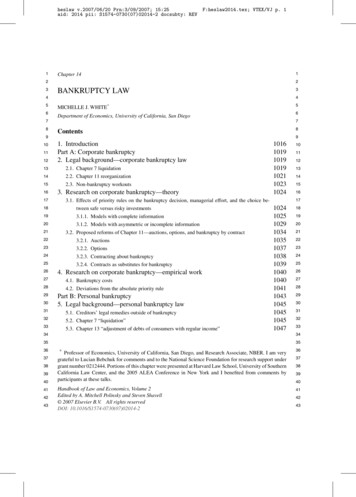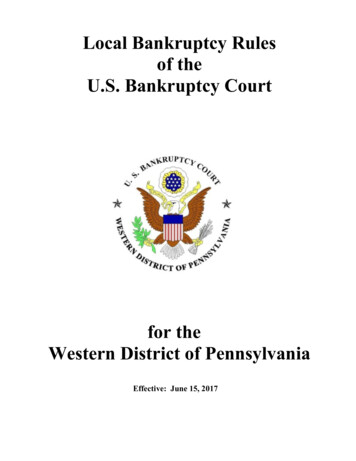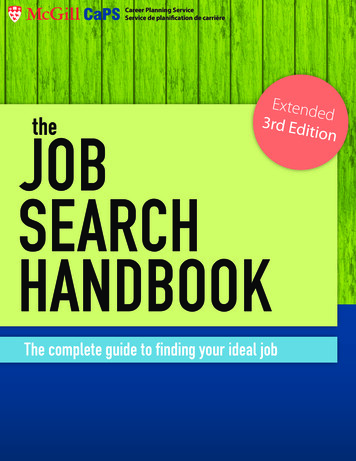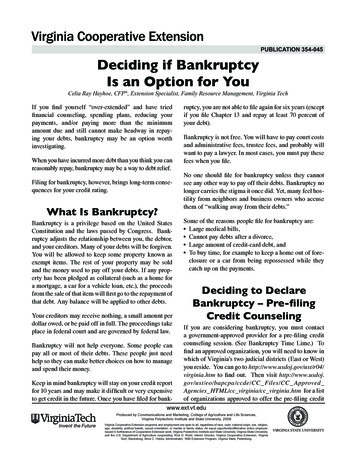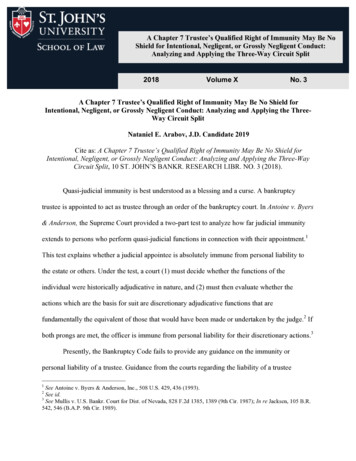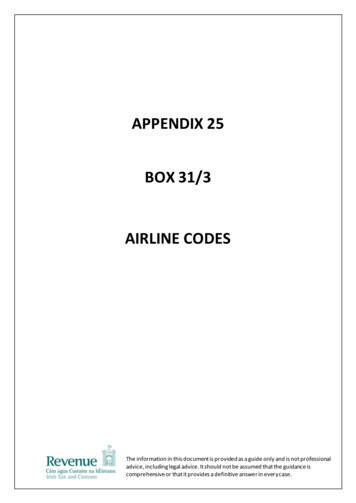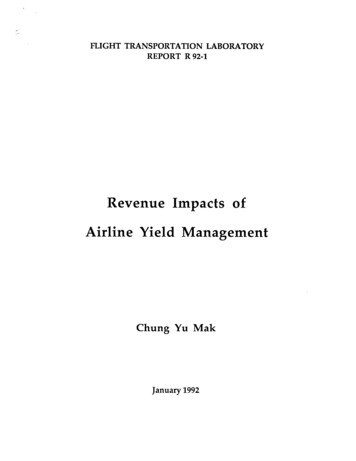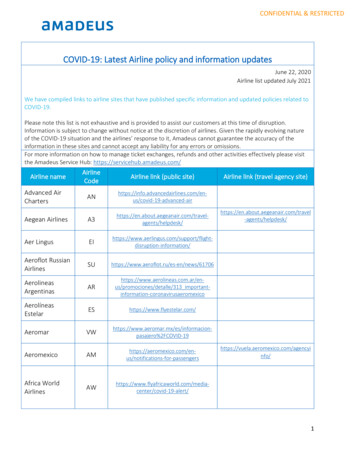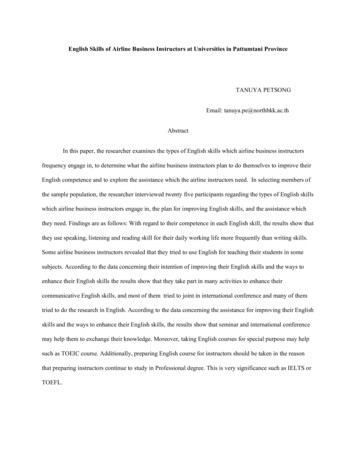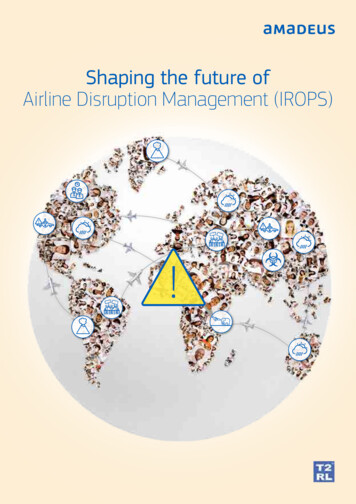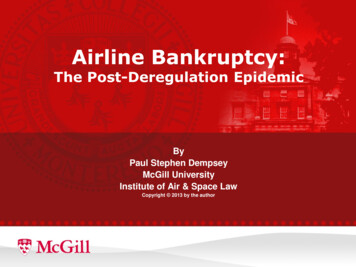
Transcription
Airline Bankruptcy:The Post-Deregulation EpidemicByPaul Stephen DempseyMcGill UniversityInstitute of Air & Space LawCopyright 2013 by the author
“Airline deregulation is a bankrupt policy.”Hobart RowenWashington Post columnist
Every major US interstate airline at the time of deregulation in1978 has since visited bankruptcy court, several more thanonce.
15US AIRLINE INDUSTRY NET PROFIT MARGINS 1950-2009105net profit margins0-5-10-15-20year
2000 – U.S. profit 2.5 billion2001 - U.S. loses 8.3 billion2002 - U.S. loses 11.4 billion2003 - U.S. loses 1.7 billion2004 - U.S. loses 9.1billion2005 - U.S. loses 27.2 billion2006 - U.S. profit 18.2 billion2007 - U.S. profit 7.7 billion2008 - U.S. loses 23.8 billion2009 - U.S. loses 2.5 billion2010 – U.S. profit 3.6 billionUS Carriers cumulatively lost 52 billion inthis decade.
U.S. General Accountability Office “Structurally, the airline industry is characterized by high fixedcosts, cyclical demand for its services, intense competition, andvulnerability to external shocks. As a result, airlines have beenmore prone to failure than many other businesses, and the sector’sfinancial performance has continually been very weak . . . . “Since the 1978 economic deregulation of the U.S. airlineindustry, airline bankruptcy filings have become prevalent in theUnited States, and airlines fail at a higher rate than companies inmost other industries.” U.S. Government Accountability Office, Commercial Aviation: Bankruptcy and Pension Problems are Symptoms ofUnderlying Structural Issues (Sep. 2005).
Liquidation or Reorganization? The purpose of bankruptcy is to give honest debtors a “fresh start”by relieving them of most debt, and to repay creditors in an orderlymanner to the extent the assets of the debtor are adequate. Because the “going concern value” of an airline is typically greaterthan the liquidation of the carrier, most airlines opt for Chapter 11reorganization bankruptcy. Many, however, are dismembered in Chapter 7 liquidations.
Voluntary or Involuntary? Bankruptcy proceedings may be classified aseither voluntary or involuntary. A voluntary bankruptcy is filed by the debtor,whereas an involuntary bankruptcy is filed by thecreditors.
New York AirwaysAeroamericaFlorida AirlinesIndiana AirwaysAir BahiaTejas AirlinesMountain WestLANICACoral AirPacific CoastSwift Aire LineGolden GatePinehurst AirlinesSilver StateAir PennsylvaniaCochise AirlinesBraniff InternationalAstec Air EastWill’s AirAero Sun Int’lAero Virgin IslandsAltairNorth AmericanIsland EmpireState AirlinesGolden WestContinental AirlinesNational FloridaAir VermontPacific ExpressDolphinCombs AirwaysNew York HelicopterAir FloridaExcellairAmerican Int’lEmeraldHammonds CommuterAir NorthWright Air LinesOceanaire LinesAtlantic GulfConnectaireAir OneExec ExpressCaribbean ExpressPocono Airlines, Inc.Virginia Island SeaplanePrinceton Air LinkQwest AirSouthern Jersey AirwaysEastern Air LinesBig Sky AirlinesAir KentuckyBraniff, Inc.PresidentialResort CommuterPocono AirlinesSMB Stage LinesCC AirBritt AirwaysRocky Mountain AirwaysContinental AirlinesPan Am World AirwaysPan Am ExpressL’ExpressEastern Air LinesBar Harbor AirlinesNorthcoast ExecutiveMidway AirlinesGrand AirwaysMetro AirlinesMohawk AirlinesJet ExpressMetro AirlinesNortheastAmerica WestMidway AirlinesFlagship ExpressVirgin Island SeaplaneTrans World AirlinesL’ExpressMarkAirHermans/Markair ExpressStates West AirlinesHawaiian AirlinesFlorida WestUSAfrica AirwaysMarkAirTrans World AirlinesGrand AirwaysThe Krystal CompanyGP ExpressBusiness ExpressJet AspenKiwi InternationalConquestAir 21Sun Jet InternationalMahaloAir SouthWestern Pacific AirlinesMountain Air ExpressPan American WorldEuram Flight CenterSunjet InternationalEastwind AirlinesAccess AirUS AIRLINE BANKRUPTCIESTower AirKitty HawkPro AirFine Air ServicesLegend AirlinesNational AirlinesTrans World AirlinesMidway AirlinesSun Country AirlinesVanguard AirlinesUS AirwaysUnited AirlinesHawaiian AirlinesMidway AirlinesGreat Plains AirlinesAtlas Air/Polar Air CargoUS AirwaysATA AirlinesSoutheast AirlinesAloha AirlinesDelta Air LinesComairNorthwest AirlinesTransMeridianMesaba AirlinesEra AviationIndependence AirFlorida CoastalKitty Hawk AircargoMAXjet AirwaysAloha AirlinesATA AirlinesSkybus AirlinesFrontier AirlinesEos AirlinesSun CountryPrimaris AirlinesArrow Air
Defunct European Airlines AerisFranceBankrupt 2004.Aero FlightOberurselGermanyOperating licence not renewed.Air AdriaticRijekaCroatiaCeased operations in March 2007Air AnatoliaTurkeyCeased Operations.Air EuropeItalyOperations Suspended.Air HollandNetherlandsClosed.Air ItalicaPescaraItalyCeased Operations.Air LithuaniaKaunasLithuaniaBankrupt November 2005.Air LittoralMontpellierFranceCeased Operations Feb 2004.Air LivoniaTallinnEstoniaCeased operationsAir LuxorLisbonPortugalCeased operations October 2006Air MadridMadridSpainCeased Operations Dec 2006.Air PoloniaWarsawPolandFlights Suspended 2004.Air ScandicCeased Operations Sep 2005.Air ScotlandGlasgowUnited KingdomOperations Suspended December 2006.Air ScotlandAir TurquoiseBéthanyFranceCeased operations August 2006.Air WalesSwanseaUnited KingdomCeased Operations April 2006ADA AirTiranaAlbaniaClosed January 2007.ajetLarnacaCyprus(Formerly Helios Airways)Flights ceased November 2006.Albatros AirwaysTiranaAlbaniaGrounded September 2006.AlpaOne AirwaysUnited KingdomAmber AirKaunasLithuaniaSuspended operations October 2007.Angel AirlinesRomaniaBankrupt and closed in 2004.Armenian International AirlinesYerevanArmeniaBankrupt April 2003Axis AirwaysMarseille Provence AirportFranceCeased operations December 2009Azzurra AirItalyCeased Operations 2004.BackpackersXpressStartup Failed.Basiq AirAmsterdamNetherlandsMerged with Transavia.Berlin JetBerlinGermanyCeased Operations.Bexx AirSofiaBulgariaOperations Suspended.Bexx AirBritanniaUnited KingdomRebranded as Thomsonfly in 2005.Britannia AirwaysBritishJet.comMalta International AirportMaltaCeased operations 2008.British NorthWest AirlinesBlackpoolUnited KingdomCeased operations December 2006CentaviaBelgradeSerbiaDeclared Bankrupt November 2006.CentralwingsWarsawPolandMerged with LOT 2008/2009.CentralwingsChannel ExpressBournemouthUnited KingdomRebranded to become Jet2.com inJanuary 2006.ClickairBarcelonaSpainMerged with Vueling, July 2009.Club AirMilanItalyGrounded 2008.Dalavia AirlinesKhabarovskRussiaOperations suspended October 2008.dbaMunichGermanyBought by Air Berlin.dbaDirect Fly
WarsawPolandSuspended operations May 2007.Domodedovo AirlinesMoscowRussiaSuspended operations September 2008due to the AiRUnion collapse.duoBirminghamUnited KingdomClosed.DutchBirdNetherlandsSuspended all operations.EUjetShannonIrelandClosed.EuroManxIsle of ManUnited KingdomCeased operations May 2008.European Air ExpressCologne/BonnGermanyClosed September 2007.FairlineGrazAustriaClosed.Falcon AirMalmöSwedenCeased operations in 2006Fare 4UMalta International AirportMaltaAir Malta low cost airline closed.Fly EcoFranceClosed.Fly GibraltarGibraltar AirportGibraltarStartup never started. FlyjetLondon LutonUnited KingdomCeased operations October 2007.flyLAL - Lithuanian AirlinesVilniusLithuaniaSuspended operations January 2009.FlyMeGothernburgSwedenBankrupt March 2007.FlyNordicStockholmSwedenMerged with Norwegian Air ShuttleApril 2008.Flying FinnHelsinkiFinlandBankrupt 2004.Fly WestBrestFranceWebsite Not Found 2005.FreshAerDublinIrelandClosed.FuturaPalma de MallorcaSpainCeased trading September 2008.Gandalf AirlinesItalyBankrupt Feb 2004.GlobespanGlasgow PrestwickUnited KingdomClosed December 2009.HapagflyHanoverGermanyMerged with HLX in January 2007 to formTUIfly.com.HapagflyHapag-Lloyd ExpressHanoverGermanyMerged with Hapagfly in January 2007to form TUIfly.com.HLXHelios AirwaysLarnacaCyprusRebranded as ajet March 2006.Hellas JetAthensGreeceClosed 2005.Hemus AirSofiaBulgariaMerged with Bulgaria Air.JetOnlyBrusselsBelgiumNow Jetairfly.comJetmagicCorkIrelandClosed.Karat AirlinesMoscowRussiaClosedLowFare JetHannoverGermanyClosed.LTE International AirwaysPalma de MallorcaSpainSuspended operations November 2008.LTUDüsseldorfGermanyMerged with Air Berlin 2009.LTUMaersk AirCopenhagenDenmarkMerged with Sterling,September 2005.Malev Hungarian AirlinesBudapestHungaryBankrupt Feb 2012.MalevMyAirItalySuspended operations July2009.Nordic AirwaysStockholmSwedenLicence cancelled January2009.Nordic RegionalStockholmSwedenAll operations werecancelled in 2008.NowLondon LutonUnited KingdomStartup Deferred.Odette AirwaysZurichSwitzerlandClosed 2004.
Olympic AirlinesAthensGreeceCeased operations 29 September 2009,successor Olympic Air.Omskavia AirlinesOmskRussiaSuspended October 2008.Pulkovo AirlinesSt.PetersburgRussiaMerged with Russia State TransportCompany to form Rossiya, Oct 2006.www.rossiya-airlines.ruRockhopperAlderney, GuernseyChannel IslandsNow known as Blue Islands.www.blueislands.comSamara AirlinesSamaraRussiaSuspended operations September 2008due to the AiRUnion collapse.Sibaviatrans AirlinesSuspended operations September 2008due to the AiRUnion collapse.SilverjetLondon LutonUnited KingdomSuspended operations May 2008.SilverjetSky EuropeBratislaviaSlovakiaBankrupt September 2009.SkyEuropeSkynet AirlinesShannonIrelandBankrupt 2004.Slovak AirlinesBratislaviaSlovakiaCeased operations in February 2007.SN Brussels AirlinesBrussels InternationalBelgiumMerged with Virgin Express to form Brussels AirlinesSpanairSpainBankrupt Jan 2012.SpanairSpirit of BalkanNever StartedStar AirlinesParis CDGFranceNow owned by the XL Leisure Group and rebranded as XLAirways nkrupt October 2008.SterlingStyrian SpiritGrazAustriaBankrupt 2006.SwedlineSwedenClosed August 2006Tempelhof ExpressGermanyClosed 2001.UK International AirlinesSheffieldUnited KingdomSuspended operations December2007.V BIRDDüsseldorf NiederrheinGermanyBankrupt 2004.Viking AirlinesStockholmSwedenCeased operations on 18 October2010.Virgin ExpressBrusselsBelgiumMerged with SN Brussels Airlines toform Brussels Airlines.Virgin ExpressXL AirwaysLondon GatwickUnited KingdomWent into administration September2008.XL Airways
The Largest Airline Bankruptcies AirlineYearAsset Value 201220022005200520042002199019891992 24.7 billion 22.8 billion 21.6 billion 14.4 billion 8.6 billion 8.0 billion 7.7 billion 4.0 billion 2.9 billionAmericanUnitedDeltaNorthwestUS AirwaysUS AirwaysContinentalEasternTWA
Notable Liquidations Braniff was liquidated in 1982. Pan Am entered bankruptcy in 1989 andwas liquidated. Eastern entered bankruptcy in 1991 andwas liquidated. TWA was folded into American on theverge of liquidation. In Europe, British Caledonian, LakerSkytrain, Sabena, Swissair, Olympic,Malev and Spanair were liquidated. InAmerica, Mexicana ceased operations.
Trans World Airlines TWA owned by Howard Hughes from 1941-1961.In 1967, TWA became the first all-jet airline.In the 1980s, Trans World Airlines operated moretransatlantic flights than any other airline.In 1985, TWA was acquired in an LBO by Carl Icahn.TWA was collapsed into Chapter 11 bankruptcy threetimes:19921995, and2001On the verge of liquidation, TWA was sold toAmerican Airlines.
US Airways US Airways entered bankruptcy in August 2002, after a failedmerger with United Airlines that stretched through 2000-2001. US Airways emerged from bankruptcy in March 2003. But it fell into bankruptcy again in September 2004. US Airways emerged in September 2005, when it wasacquired by American West. America West also had filed for bankruptcy more than adecade earlier, in June of 1991. Although America West was the acquiring company, it namedthe combined airline US Airways.
United Airlines United filed for bankruptcy protection in December 2001. In so doing, United became the largest airline and sixthlargest U.S. company (by assets) in history to file underChapter 11. UAL listed assets of 22.8 billion and liabilities of 21.5billion. United was facing 920 million of past due debt repaymentslooming within a week of the filing. After more than three years of restructuring, United emergedin February 2006.
Continental Airlines After a LBO by Frank Lorenzo,Continental Airlines declared bankruptcyin 1983. It filed for bankruptcy a second time in1990. Continental emerged in 1993 after aninvestment by Air Canada and the TexasPacific Group. Continental was acquired by UnitedAirlines in 2011.
American Airlines In 2011, AMR had a net loss of 471 million. Delta had net earnings of 593million; United earned 854 million. AMR has lost nearly 5 billion since 2007.As of November 1, 2011, American Airlines had a fleet of over 600 jet aircraftand provided approximately 1,800 scheduled daily departures to approximately160 destinations. As of September 30, 2011, AMR had consolidated reportedassets and liabilities of approximately 24.72 billion and 29.55 billion,respectively. AMR employed more than 88,000 people.American Airlines entered bankruptcy in November 2011.In January 2012, US Airways hired investment bankers Barclays Capital andMillstein & Co., and law firm Latham & Watkins LLP to help it assess a possiblebid for AMR.Delta Air Lines Inc. and private equity firm TPG Capital also expressed interest inpurchasing or investing in AMR.
Foreign Airline Bankruptcies Laker Skytrain liquidated.British Caledonian liquidated.Sabena liquidated.Swissair liquidated.Olympic Airlines ceased ops 2009.Air Canada entered bankruptcy in April 2003, emerging in September2004.Japan Airlines entered bankruptcy in January 2010, emerging in March2011, after raising 3 billion in new capital, cutting one-third of its staff,grounding more than 100 aircraft, and abandoning 49 routes.Mexicana entered bankruptcy in August 2010 and suspended operations.Spanair and Malev ceased operations in 2012.
Too Big to Die? Given the 20- to 30-year life of airline capital assets (aircraft), and the highcash flows generated from ticket sales, an airline can go through a very longperiod of chronic illness before rigor mortis sets in. Moreover, the “goingconcern value” often is larger than the liquidation value of an airline.Large airlines have an interesting advantage over small airlines inbankruptcy. Because large airlines typically have large inventories of leasedaircraft and large amounts of debt owed to various creditors, those lendershave the biggest stake in the success of the bankruptcy reorganization, andare most likely to provide the DIP financing and concessions necessary forreorganization. The threat of a large airline to return aircraft to lessors in asoft market can instill financial generosity in the cold heart of a lessor.Because large communities will also be adversely affected should the carrierbe liquidated, large airlines also have considerable political power at theirdisposal to assist them should the regulators or pension agencies becomedifficult.
US Bankruptcy Laws Chapter 7 is liquidation. It is a complete termination of the business. The trusteecollects the debtor’s assets, reduces them to cash, and distributes the proceeds tocreditors on a pro-rata basis, though secured creditors receive preferential treatmentvis-à-vis unsecured creditors and stockholders.Chapter 11 is reorganization. The debtor is given protection from creditors while itreorganizes itself. It may reject any outstanding contract (except a labor agreement),subject only to the “business judgment” or “benefit to the estate” test. It may alsoseek to reschedule or reduce payment of its debts. The company is allowed to deferexisting obligations, except for aircraft payments. A company that fails to reorganizesuccessfully may find itself in Chapter 7 liquidation proceedings.Chapter 15 involves cross-border issues. It codifies the UNCITRAL Model Law onCross-Border Insolvency. Usually, it is ancillary to a bankruptcy proceeding broughtin the debtor’s home country. Generally, it applies only to the foreign debtor’s assetsin the United States. For example, Mexicana filed for Chapter 15 bankruptcyprotection in the U.S. Bankruptcy Court for the Southern District of New York onAugust 2, 2010.
US Bankruptcy Laws Section 1110 addresses the return of aircraft to lenders or lessors having asecurity interest in them. Once an airline falls into bankruptcy, it enjoys anautomatic stay from making lease payments on that asset for only 60 daysafter the filing of bankruptcy, after which the lessor or lender free to repossessthe aircraft unless, it enters into an agreement to defer payments with thelessor. Failure enables the aircraft to be repossessed. The BankruptcyReform Act of 1994 clarified the law to give equal protection to lease financingagreements of aircraft equipment and all debt financing that involves asecurity interest, irrespective of whether the interest is obtained at the time theequipment was acquired.Section 1113 allows the Bankruptcy Court to amend the Collective BargainingAgreement between the airline and its unions unions if: (1) the debtor hassubmitted a modification proposal that satisfies certain proceduralrequirements; (2) the union refuses to accept the proposal without “goodcause”; and (3) the balance of the equities clearly favors rejection of the CBA.
Debtor in Possession Management is given the exclusive right to file a reorganization plan for 120 days,though the deadline may be, and often is, extended by the bankruptcy judge for cause.Usually, management remains in control of the airline while in Chapter 11, as the“Debtor in Possession,” [DIP].Subject to the supervision of the Bankruptcy Judge, the DIP carries on theoperation the business under an automatic stay, protecting the debtor from creditors’demands for payment. Significant decisions, however, must be approved by the Judge.The objective of Chapter 11 is to restructure the business and financial obligations ofthe debtor so that the company becomes viable. The stay enables the debtor to bringthe creditors together for discussion, explanation and negotiation. If negotiations aresuccessful, the DIP will file a plan for reorganization containing proposals for repaymentof the debt and reorganization of the company. The Bankruptcy Judge may confirm theplan. The debtor may then attempt to implement it. Success or failure will dependupon several variables, such as: (1) the adequacy of capital; (2) the earnings of thecompany; (3) economic conditions; and (4) the quality of management. If the plansucceeds, the debtor emerges from Chapter 11 discharged of its prepetition debt.
Trustee in Bankruptcy There are some 90 bankruptcy courts in the United States, one in each judicialdistrict. The Bankruptcy Judge appoints a trustee to oversee the estate. Thetrustee’s role is to take charge of the estate, investigate irregularities such asfraudulent transfer or preferential transfer, see that creditors are treated fairly,receive claims, liquidate property and/or distribute available funds. Irregularitiessuch as fraudulent and/or preferential transfer are common transgressions wherebankruptcy is imminent. These irregularities result from attempts by debtors toretain assets at the expense of creditors. Fraudulent transfer is the transfer ofmoney or property to “defraud” creditors. A common example of fraudulent transfermight be the transfer of company funds to immediate relatives just prior to filing forbankruptcy protection. Conversely, preferential transfer occurs when certain,“preferred” creditors are paid in full while leaving others partially or totally unpaid.Under “avoiding powers”, transfers of money or property concluded within the 90days preceding bankruptcy can be voided by the trustee, and the assets forciblyreturned to the bankrupt estate. Transactions by insiders may be voided up to ayear prior to filing. 11 U.S.C. §§ 101(31), 101(54), 547, and 548.
Bankruptcy Abuse Preventionand Consumer Protection Act of2005 Congress also amended the Bankruptcy Code with the whichtightened rules on debtors. It extended pre-petition liability of theestate on claims for unpaid wages to 10,000 and increased thereach back period from the prior 90 days, to 180 days. It alsolimited the time period during which management has theexclusive right to file a reorganization plan to 18 months. Postpetition wages are administrative expenses, given first priority forpayment without any dollar limitation. Pub. L. 109-8 (2005).
Plan of Reorganization –Delta Delta and Northwest Airlines filed bankruptcy in 2005 before thenewly-imposed 18-month limit went into effect. Delta’s plan of reorganization sought to achieve 970 millionthrough bankruptcy restructuring. It hoped to reduce costs byretiring four of its 11 aircraft types, and shrinking its overall fleetby 80 planes, of which half would be lease rejections, resulting in 607 million in savings. It sought to close its Dallas andCincinnati hubs, and increase the efficiency of its Atlanta hub.Delta sought 325 million in reduced labor and benefit costs,including a 20% pay cut. Finally, it sought reorganization of itsdefined benefit pension plans, which were underfunded by 5billion.
Plan of Reorganization Northwest Northwest sought permission to void its collective bargainingagreements after its unions refused pay cuts of approximately 950 million. It hoped to out-source all maintenance work, cutwages, base many of its flight attendants in foreign venues,create a new low-cost subsidiary airline flying 77-100 seataircraft, and return 13 aircraft to lessors. Northwest hoped thatbankruptcy reorganization would result in a profit improvementof between 2.2- 2.5 billion. Ultimately, both Delta andNorthwest emerged from bankruptcy, and merged together.
Northwest in CHAOSNorthwest Airlines successfully abrogated its CBA with its flight attendants’union in its 2005 bankruptcy filing. The union responded by notifyingNorthwest that it intended to disrupt the carrier’s operations with a tacticit dubbed “CHAOS” (“Create Havoc Around Our System”). Northwestsought an injunction. The court granted the injunction, finding:1. Northwest abrogated (but did not breach) the CBA by successfullysecuring bankruptcy court approval under section 1113,2. abrogation terminated the status quo created by that agreement, and3. the union’s strike would violate its duty under the Railway Labor Act[RLA] to use every effort to conclude a new agreement.Instead of striking, the RLA compelled the union to use “every reasonableeffort” to conclude a new contract that would establish a new status quo.
Plan of Reorganization –American Airlines American Airlines to slash 13,000 jobs, demands deep concessions By Shannon Jones 3 February 2012 American Airlines . . . plans to eliminate 13,000 jobs, make draconian changes to work rules andcut wages, pensions and healthcare benefits. The measures are expected to slash labor costs bysome 20 percent.American Airlines . . . estimates that its proposals will save some 2 billion a year. Sixty percentof the savings will come off the backs of its workers.Management says it will seek the approval from the bankruptcy court to terminate its traditionalpension plan and substitute an inferior 401(k) plan. According to the federal Pension BenefitGuarantee Corporation (PBGC), American has a 10 billion shortfall in its employee pensionaccount. This week the PBGC put liens on 91 million in AMR property after the company paidonly 6.5 million of a required 100 million into its pensions. American workers stand to lose 1billion if their pensions are terminatedAmerican and its regional carrier American Eagle employ a combined 88,000 full and part timeemployees. The company wants to cut the jobs of 4,600 mechanics, 4,200 ground serviceworkers, 2,300 flight attendants, 400 pilots and 1,400 management and support workers. Thecompany is planning to close its maintenance base at Fort Worth’s Alliance Airport and outsourcemaintenance operations. The airline is also planning an unspecified number of job cuts for gateagents, service representatives and airline planners.
Plan of Reorganization – Air Canada Debtor-in-Possession Financing;Aircraft Lease Restructuring;Cost Restructuring;New Aircraft Orders;Corporate Reorganization;Reduction of Pension Liabilities;Bondholder Negotiations;Exit Debt Financing;Exit Equity Financing;Rights Offering to Creditors;Claims Process; and/orEmergence Plan
Air Canada’s Calin Rovinescu observed, navigating an airlinebankruptcy is “like playing full-contact multi-dimensional chess ina fish bowl.”
Duration Airline bankruptcy overall duration averages 714 days (fifth among U.S.industries, and significantly higher than the average of all industries of 518days). U.S. Government Accountability Office, Commercial Aviation: Bankruptcy and Pension Problems are Symptoms ofUnderlying Structural Issues 23 (Sep. 2005). At 1,150 days, the longest and most expensive bankruptcy in aviationhistory was that of United Airlines, which emerged in 2006. The companyspent 400 million in consulting and legal fees on the transaction. Uponexiting bankruptcy, United management announced it was giving itself andother salaried employees about 100 million in stock and other equity—that after taking some 3 billion from employees in wage and benefitconcessions, as well as their pension plans. Marilyn Adams, United Leaves Bankruptcy Behind, USA Today, Feb. 6, 2006, at 3B.Lavish Payout for Management, Rocky Mountain News, Dec. 17, 2005, at 14C. Congress in 2005 amended the Bankruptcy Code to limit the exclusiveright of the debtor-in-possession to file a reorganization plan to 18months.
Criteria for Extension ofExclusivity Period (i) the size and complexity of the debtor’s case;(ii) the necessity for sufficient time to permit the debtor to negotiate a chapter 11plan and prepare adequate information;(iii) the existence of good faith progress towards reorganization;(iv) the fact that the debtor is paying its bills as they become due;(v) whether the debtor has demonstrated reasonable prospects for filing a viableplan;(vi) whether the debtor has made progress in negotiations with its creditors;(vii) the amount of time which has elapsed in the case;(viii) whether the debtor is seeking an extension of exclusivity in order to pressurecreditors to submit to the debtor’s reorganization demands; and(ix) whether an unresolved contingency exists.
Amending Collective BargainingAgreements in Bankruptcy CourtTHE PROCEDURES: The debtor must make a proposal to the union providing for modification of the CBA; The debtor must provide the union with relevant information to evaluate the proposal; The debtor must meet with the union and confer in good faith in an attempt to reach mutuallysatisfactory modifications to the CBA; After an application has been filed, the bankruptcy judge must schedule a hearing within 14days (which can be extended by 7 days, or longer if all parties agree); and The court must make a ruling within 30 days of the beginning of the hearing unless all partiesagree to an extension. Upon completion of these hurdles, the Bankruptcy Judge can reject the CBA if: (1)the debtor has made the modification proposal that satisfies the procedures describedabove; (2) the union refuses to accept the proposal without “good cause”; and (3) thebalance of the equities clearly favors rejection of the CBA.1 U.S.C. § 1113(b),(d). John Gallagher, Jon Geier & Margaret Spurlin, An Unhappy Crossroads: The Interplay ofBankruptcy and Airline Labor Law, address before the ABA Forum on Air & Space Law, Washington, D.C. (Feb. 2,2006).
Allegheny-Mohawk LPPsFrom 1950-1978, the CAB imposed Labor Protective Provisions [LPPs]in each of the 43 mergers and acquisition applications it approved.Typically, they had these characteristics (known as Allegheny-MohawkProvisions: Displacement allowances for those having to move domiciles due tomerger-related restructuring; Dismissal allowances for those furloughed as a result of mergers; The right to continued health benefits for furloughees; Reimbursement for personal losses resulting from mergers, such asforced home sales; and Guarantees that seniority lists would be combined in a fair andequitable manner.
LPPs Incorporated into CBAs The post-deregulation CAB and the USDOT refused to imposeLPPs in any airline merger, advising unions to negotiate theirown merger protections through collective bargaining. Typically, provisions addressing seniority integration have beenincorporated into the airline/union CBAs. Many CBAs of thelegacy airlines included provisions mirroring the AlleghenyMohawk seniority integration rules. They ordinarily provide foremployee seniority integration in a “fair and equitable manner”,and mandatory arbitration to resolve LPP disputes. Often,employees in merged airlines were integrated on a date-of-hireseniority basis or according to a formula established by a neutralarbitrator (e.g., three from the acquiring airline, one from theacquired airline, based on date of hire).
Labor Betrayal in the AirlineDeregulation ActTo soften the impact of deregulation upon displaced workers, and temperpolitical resistance to deregulation, the Airline Deregulation Act includedEmployee Protection Provisions [EPPs], including: the right of first hire at another airline; and monthly assistance payments to furloughed or terminated eligible“protected employees” suffering economic injury as a result of a“qualifying dislocation”, defined as an airline bankruptcy or majorcontraction “the major cause of which is the change in regulatorystructure provided by the Airline Deregulation Act.”BUT NEITHER THE CAB NOR THE DOT EVER FOUND AN AIRLINEBANKRUPTCY WAS CAUSED BY DEREGULATION, AND CONGRESSNEVER FUNDED THE PROGRAM
American-TWA: Tail-Ending The1998
Air New Orleans Air Virginia Mid Pacific Airlines Exec Express Caribbean Express Pocono Airlines, Inc. Virginia Island Seaplane Qwest Air Southern Jersey Airways Eastern Air Lines Air Kentucky Braniff, Inc. Presidential Pocono Airlines SMB Stage Lines CC Air Britt Airways Rocky Mountain Airways Continental Airlines Pan Am World Airways L'Express Eastern Air Lines Bar Harbor Airlines Midway .

